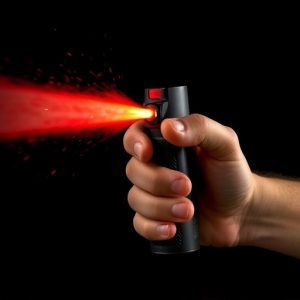Navigating Pepper Spray Exposure: Treatment, Prevention & Legal Rights
TL;DR:Pepper spray, using capsaicin for crowd control, requires immediate and proper treatment. For…….
TL;DR:
Pepper spray, using capsaicin for crowd control, requires immediate and proper treatment. For eye or skin contact, flush/rinse with water, remove contaminated clothing, and apply a cold compress. Move to a well-ventilated area and monitor symptoms like coughing or vision issues. Inhalation needs urgent attention; seek medical help if symptoms persist. Prevention involves wearing protective gear and quickly moving to fresh air upon exposure. Understanding legal rights and potential long-term health effects is crucial, along with learning effective treatment methods for pepper spray exposure.
“Discover the powerful tool of inflammatory riot control spray and its profound effects on crowd control. This article guides you through the intricacies of understanding and managing pepper spray exposure, offering practical advice for both immediate and long-term care. From recognizing symptoms to legal rights, learn essential strategies on how to treat pepper spray exposure effectively. Master prevention techniques and know your legal standpoints to navigate these encounters with confidence.”
- Understanding Inflammatory Riot Control Spray and Its Effects
- Immediate Steps to Take After Pepper Spray Exposure
- Medical Treatment for Pepper Spray Irritation
- Prevention Strategies for Protecting Against Pepper Spray
- Legal Considerations and Rights During Encounters with Pepper Spray
Understanding Inflammatory Riot Control Spray and Its Effects
Inflammatory riot control spray, also known as pepper spray, is a powerful tool used by law enforcement and security personnel for crowd control and riot suppression. It contains capsaicin, the active ingredient found in chili peppers, which causes irritation and temporary incapacitation when sprayed onto the eyes, skin, or respiratory system. Understanding how this spray works and its effects on the human body is crucial for both those who use it and those at risk of exposure.
In case of pepper spray exposure, immediate and proper treatment is essential. This includes thorough washing of the affected areas with water to dilute the chemical. If the spray gets into the eyes, flushing them with clean water for at least 15 minutes can help reduce irritation and pain. For skin exposure, removing any contaminated clothing and rinsing the skin with water can alleviate discomfort. Inhalation of pepper spray may require moving the affected individual to a well-ventilated area and providing oxygen if necessary. How to Treat Pepper Spray Exposure is a key consideration for anyone in law enforcement or attending public events where such sprays might be used.
Immediate Steps to Take After Pepper Spray Exposure
After exposure to pepper spray, the first steps should be taken immediately to mitigate its effects. If your eyes are affected, rinse them gently but thoroughly with clean water for at least 15 minutes. This helps to flush out any residual irritants. It’s crucial to move to a safe, well-ventilated area to avoid further inhalation of the spray.
For skin contact, remove any clothing or accessories that have been contaminated and rinse the affected areas with water. Apply a cold compress to reduce discomfort. If breathing is difficult, seek fresh air immediately. How to treat pepper spray exposure also involves monitoring symptoms like coughing, chest tightness, or difficulty seeing, as these could indicate more severe reactions that require medical attention.
Medical Treatment for Pepper Spray Irritation
Pepper spray, a common tool for riot control, can cause significant irritation and discomfort when exposed to eyes, skin, or respiratory system. The first step in how to treat pepper spray exposure is to immediately flush any affected areas with plenty of water for at least 15 minutes. This helps to dilute the chemical and prevent further absorption. If the exposure was to the eyes, hold them open and rinse gently under a gentle stream of water. For skin contact, remove any contaminated clothing and wash the area thoroughly with soap and warm water.
Inhalation of pepper spray can lead to coughing, difficulty breathing, or irritation in the throat and nose. Move the affected individual to an area with fresh air immediately. If necessary, provide oxygen support and seek medical attention if symptoms persist or worsen. Additionally, applying a cold compress to the face and neck areas can help alleviate pain and swelling.
Prevention Strategies for Protecting Against Pepper Spray
Preventing exposure to pepper spray is key to safeguarding yourself during riots or similar chaotic situations. One of the first lines of defense is to maintain a safe distance from the source of the spray. Rioters often use pepper spray tactically, so staying away from the immediate area can significantly reduce risk. Wearing protective gear, such as a face mask and goggles, is another effective strategy. These barriers create a physical shield against airborne spray particles.
In case exposure occurs, knowing how to treat pepper spray exposure is crucial. If exposed, quickly move to a clean, well-ventilated area. Rinse your eyes thoroughly with water for at least 15 minutes to flush out any irritants. Remove contaminated clothing and wash your skin with soap and warm water. Seek medical attention if symptoms persist or worsen, as pepper spray can cause respiratory distress, skin irritation, and other adverse effects.
Legal Considerations and Rights During Encounters with Pepper Spray
When facing off against an inflammatory riot control spray dispenser, understanding your legal rights and the implications of pepper spray exposure is paramount. In many jurisdictions, law enforcement or security personnel are required to inform individuals about the nature and effects of the spray before deployment. This includes disclosing that it can cause temporary blindness, difficulty breathing, and severe skin irritation.
If you find yourself on the receiving end of such a spray, knowing how to treat pepper spray exposure is crucial. Immediately after exposure, move to an area with fresh air. Remove any contaminated clothing and wash affected areas with plenty of water. Seek medical attention if symptoms persist or worsen, as pepper spray can cause long-term health issues, especially for individuals with pre-existing respiratory conditions. Always remember that you have the right to understand and contest any use of force, including pepper spray, ensuring your safety and due process.
Understanding how to navigate encounters with inflammatory riot control spray, or pepper spray, is crucial for public safety. By knowing the immediate steps to take after exposure, recognizing the need for medical treatment, implementing prevention strategies, and being aware of legal considerations, individuals can better protect themselves and their rights. Armed with this knowledge, folks can foster a safer environment, even in bustling areas prone to civil unrest or police interactions. Remember that understanding How to Treat Pepper Spray Exposure is a vital step towards revolutionizing community safety.


